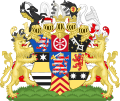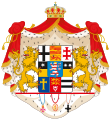
Hesse or Hessia, officially the State of Hesse, is a state in Germany. Its capital city is Wiesbaden, and the largest urban area is Frankfurt, which is also the country's principal financial centre. Two other major historic cities are Darmstadt and Kassel. With an area of 21,114.73 square kilometers and a population of over six million, it ranks seventh and fifth, respectively, among the sixteen German states. Frankfurt Rhine-Main, Germany's second-largest metropolitan area, is mainly located in Hesse.
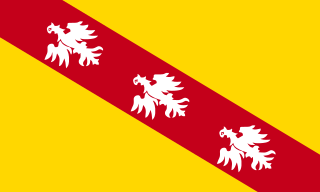
The Duchy of Lorraine, originally Upper Lorraine, was a duchy now included in the larger present-day region of Lorraine in northeastern France. Its capital was Nancy.

The House of Hesse is a European dynasty, directly descended from the House of Brabant. They ruled the region of Hesse, one branch as prince-electors until 1866, and another branch as grand dukes until 1918.

The Province of Hesse-Nassau was a province of the Kingdom of Prussia from 1868 to 1918, then a province of the Free State of Prussia until 1944.
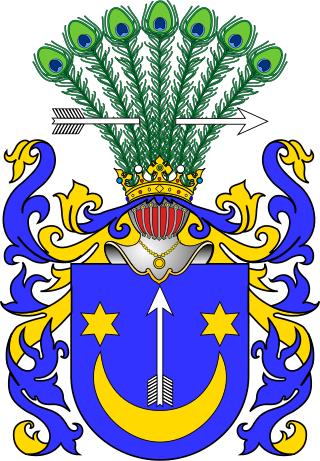
Sas or Szász is a Central European coat of arms. It was borne since the medieval period by several Transylvanian-Saxon Hungarian, Ruthenian, Ukrainian, and Polish-Lithuanian noble families. The house was once a mighty princely and ducal house with origins in Saxony, Transylvania, Hungary and Ruthenia.

The Duchy of Brunswick was a historical German state that ceased to exist in 1918. Its capital was the city of Brunswick. It was established as the successor state of the Principality of Brunswick-Wolfenbüttel by the Congress of Vienna in 1815. In the course of the 19th-century history of Germany, the duchy was part of the German Confederation, the North German Confederation and from 1871 the German Empire. It was disestablished after the end of World War I, its territory incorporated into the Weimar Republic as the Free State of Brunswick.

Frankenau is a small town in Waldeck-Frankenberg district in Hesse, Germany.

Philippsthal (Werra) is a market community in Hersfeld-Rotenburg district in eastern Hesse, Germany, right at the boundary with Thuringia.
The state of Prussia developed from the State of the Teutonic Order. The original flag of the Teutonic Knights had been a black cross on a white flag. Emperor Frederick II in 1229 granted them the right to use the black Eagle of the Holy Roman Empire. This "Prussian Eagle" remained the coats of arms of the successive Prussian states until 1947.

The Landgraviate of Hesse was a principality of the Holy Roman Empire. It existed as a single entity from 1264 to 1567, when it was divided among the sons of Philip I, Landgrave of Hesse.
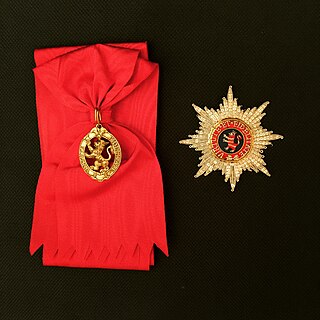
The House Order of the Golden Lion was an order of the German Landgraviate and Electorate of Hesse-Kassel and later, the Grand Duchy of Hesse and by Rhine. It was first instituted in 1770 by Landgrave Frederick II, in honour of and under the patronage of Saint Elizabeth of Hungary, an ancestor of the House of Hesse, and was intended to award auspicious merit.

The coat of arms of Bavaria has greater and lesser versions.

The coat of arms of the German state of Thuringia was introduced in 1990. Like the 1949 coat of arms of Hesse it is based on the Ludovingian lion barry, also known as the "lion of Hesse", with the addition of eight mullets.
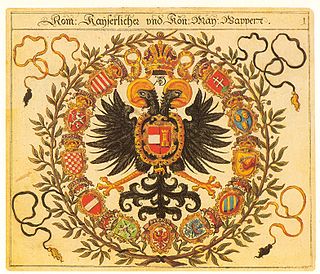
Siebmachers Wappenbuch is a roll of arms first published in 1605 as two heraldic multivolume book series of armorial bearings or coats of arms of the nobility of the Holy Roman Empire, as well as coats of arms of city-states and some burgher families. Founded and compiled by Johann Ambrosius Siebmacher, a German heraldic artist, copperplate engraver, etcher and publisher from Nuremberg, these works became an important source of heraldry of the German-speaking regions.

Frederick William George Adolphus, Landgrave of Hesse was the only son of Wilhelm I, Landgrave of Hesse-Kassel-Rumpenheim and Princess Louise Charlotte of Denmark.

The civil flag of Hesse, Germany, consists of a bicolour of a red top and a bottom white stripe, in the proportion 3:5. The state flag is similar, except it is emblazoned with the state coat of arms in the centre, and may only be used by government departments and services.

Alexander Frederick, Landgrave of Hesse was a German prince of the House of Hesse.
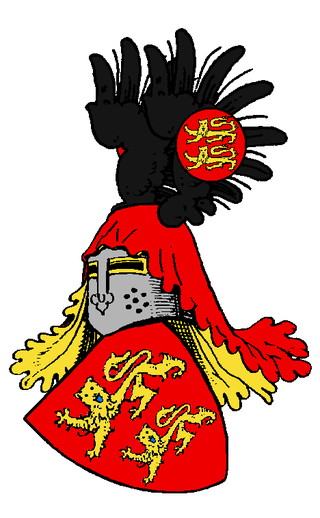
The County of Diez was a county of the Holy Roman Empire, centred around Grafenschloss in Diez, located in Lahngau. The county is first recorded in 1073, likely formed from the lands of the Conradine dynasty after their relocation to Swabia. The Counts of Diez gained prominence in the late twelfth century as strong supporters of the Hohenstaufen dynasty, earning it the nickname "Golden County."
The German Emperors after 1873 had a variety of titles and coats of arms, which in various compositions became the officially used titles and coats of arms. The title and coat of arms were last fixed in 1873, but the titles did not necessarily mean that the area was really dominated, and sometimes even several princes bore the same title.




